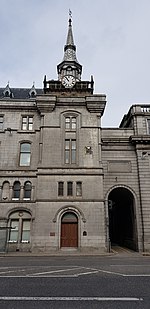Aberdeen Town House
1874 establishments in ScotlandCategory A listed buildings in AberdeenCity chambers and town halls in ScotlandClock towers in the United KingdomGovernment buildings completed in 1874 ... and 3 more
Listed government buildings in ScotlandPolitics of AberdeenUse British English from April 2022

Aberdeen Town House is a municipal facility in Castle Street, Aberdeen, Scotland. The town house, which is the headquarters of Aberdeen City Council, is a Category A listed building.
Excerpt from the Wikipedia article Aberdeen Town House (License: CC BY-SA 3.0, Authors, Images).Aberdeen Town House
Concert Court, Aberdeen City City Centre
Geographical coordinates (GPS) Address External links Nearby Places Show on map
Geographical coordinates (GPS)
| Latitude | Longitude |
|---|---|
| N 57.1481 ° | E -2.0944 ° |
Address
Town House
Concert Court
AB10 1BS Aberdeen City, City Centre
Scotland, United Kingdom
Open on Google Maps








